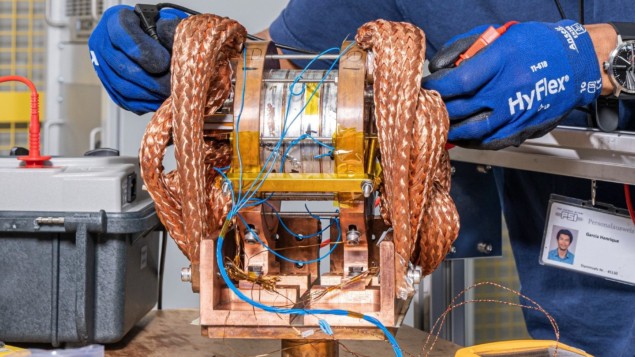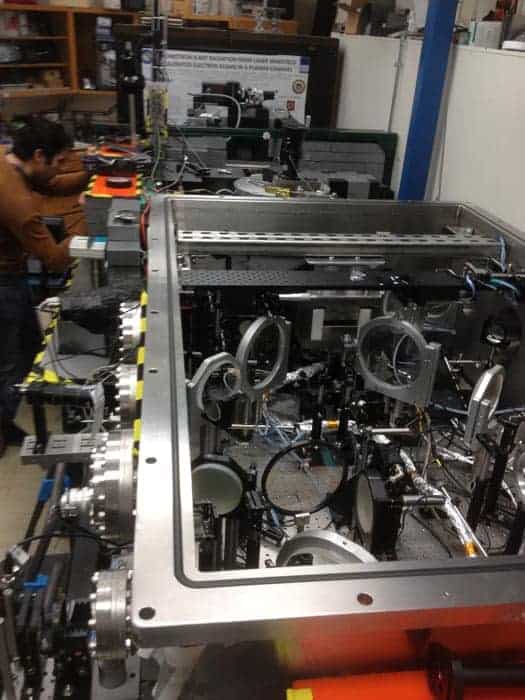
Computer simulations and laboratory experiments done in Switzerland have advanced the design of a new type of positron source that could be used in next-generation lepton colliders such as the proposed Future Circular Collider (FCC) at CERN. Developed by Nicolas Vallis and colleagues at the Paul Scherrer Institute (PSI), the design uses high-temperature-superconductor magnets to collect positrons and focus them into a tight beam. The team says that its source could be fully operational by 2026.
Positron sources for accelerators rely on an effect called pair production, whereby a high-energy photon interacts with an atomic nuclei to create a positron and an electron. This is usually done by firing a high-energy electron beam into a dense solid target. Electrons that are deflected by atoms in the target will radiate photons, which then interact with other target atoms to create the electron/positron pairs.
Although this approach creates lots of positrons, they fly off in many directions. If the positrons are destined for use in a particle accelerator, they must be gathered and focussed into a beam. This process is very inefficient, with most positrons being lost.
Magnetic and mechanical challenges
Today, the gathering and focussing is done using electromagnets called solenoids. “However, the strength of conventional magnets, even in the multi-Tesla range, only allows a small proportion of the generated positrons to be captured,” Vallis explains. “Moreover, their mechanical implementation is in conflict with the target, keeping it away from its optimal location inside the magnetic field.”
Building better positron sources is a goal of physicists and engineers working on designs for future lepton colliders. These include the International Linear Collider and a version of the FCC called FCC-ee, which would collide positrons with electrons. The PSI Positron Production, or P-cubed experiment is one such design effort.
“One of the challenges we face is to produce, capture and transport positrons in sufficiently high quantities to achieve the desired luminosity,” Vallis describes. “P-cubed addresses this problem and proposes a new positron source and capture system with the potential to enhance the current positron yield by an order of magnitude.”
Latest advances
The team’s approach is based on the latest advances in solenoids made from high-temperature superconductors (HTSs). These can generate much higher magnetic fields than solenoids that use conventional conductors.
In their latest research, Vallis and colleagues describe how their prototype positron source will be implemented at PSI’s SwissFEL X-ray free-electron laser. Pulses from SwissFEL will accelerate bunches of electrons towards a solid target that will be surrounded by the new HTS solenoid. The solenoid’s magnetic field will then focus positrons into two successive RF cavity accelerators to create a positron beam
In addition to the solenoid’s strong magnetic field, Vallis says “its mechanical design allows for a full immersion of the target in the magnetic field, enabling optimal conditions for positron capture”.
Further improvements
With this setup, the researchers could also examine how other components could help to improve positron yields. These include large aperture accelerating cavities, and novel arrangements of detection instruments. The P-cubed experiment is currently being installed at SwissFEL and it should begin operation in early 2026.

Laser creates high-energy positron beam
“If the experimental findings live up to our expectations, P-cubed will demonstrate a new positron source and capture system that outperforms the efficiency of its predecessors by an order of magnitude,” Vallis says. “On top of that, magnet experts at PSI have successfully run a prototype of the HTS solenoid, arguably the most critical component of the experiment, and measured a peak magnetic field of around 18 T.” In comparison, the strongest continuous magnetic field ever created in the lab is a little over 45 T.
“P-cubed will be one of the few positron sources suitable for particle accelerators worldwide, and a unique facility in Europe, so we want to develop its full potential and innovative capacity,” he says. “For instance, we will test a range of novel ideas, such as the use of crystal and conical targets for a further enhanced positron production.”
The research is described in Physical Review Accelerators and Beams.
- SEO Powered Content & PR Distribution. Get Amplified Today.
- PlatoData.Network Vertical Generative Ai. Empower Yourself. Access Here.
- PlatoAiStream. Web3 Intelligence. Knowledge Amplified. Access Here.
- PlatoESG. Carbon, CleanTech, Energy, Environment, Solar, Waste Management. Access Here.
- PlatoHealth. Biotech and Clinical Trials Intelligence. Access Here.
- Source: https://physicsworld.com/a/new-positron-source-could-give-lepton-colliders-a-boost/
- :has
- :is
- $UP
- 2026
- 27
- a
- accelerate
- accelerating
- accelerator
- accelerators
- Achieve
- addition
- addresses
- adjusts
- advanced
- advances
- allows
- also
- an
- and
- approach
- ARE
- arguably
- around
- AS
- At
- atomic
- away
- based
- BE
- Beam
- been
- begin
- being
- Better
- boost
- breakthrough
- built
- by
- called
- CAN
- Capacity
- capture
- captured
- challenges
- circular
- colleagues
- collect
- Collide
- comparison
- component
- components
- conditions
- conflict
- continuous
- conventional
- could
- create
- created
- creates
- critical
- Crystal
- Current
- Currently
- demonstrate
- describe
- described
- describes
- Design
- designs
- desired
- destined
- Detection
- develop
- developed
- done
- Early
- effect
- efficiency
- effort
- electrons
- enabling
- Engineers
- enhance
- enhanced
- Europe
- Even
- EVER
- examine
- expectations
- experiment
- experimental
- experiments
- experts
- Explains
- Face
- Facility
- FCC
- few
- field
- Fields
- findings
- firing
- Focus
- focussed
- For
- from
- full
- fully
- further
- future
- gathered
- gathering
- generate
- generated
- Give
- goal
- Have
- he
- help
- High
- higher
- How
- HTTPS
- ideas
- if
- immersion
- implementation
- implemented
- improve
- in
- include
- inefficient
- information
- innovative
- inside
- installed
- instance
- Institute
- instruments
- interact
- interacts
- International
- into
- issue
- IT
- ITS
- jpg
- keeping
- lab
- laboratory
- large
- laser
- latest
- linear
- little
- live
- location
- lost
- lots
- made
- Magnetic field
- Magnets
- many
- max-width
- mechanical
- Michigan
- most
- much
- must
- New
- next-generation
- novel
- of
- off
- on
- ONE
- only
- operation
- operational
- optimal
- or
- order
- Other
- our
- Outperforms
- over
- pair
- pairs
- part
- Paul
- Peak
- Photons
- Physics
- Physics World
- plato
- Plato Data Intelligence
- PlatoData
- potential
- Problem
- process
- produce
- Production
- proportion
- proposed
- proposes
- prototype
- range
- rely
- research
- researchers
- review
- Run
- says
- setup
- should
- simulations
- small
- So
- solid
- Source
- Sources
- strength
- strong
- strongest
- Successfully
- such
- suitable
- superconducting
- surrounded
- switzerland
- system
- Target
- targets
- team
- test
- than
- that
- The
- their
- Them
- then
- These
- they
- this
- thumbnail
- to
- top
- towards
- transport
- true
- two
- type
- unique
- university
- use
- used
- uses
- using
- usually
- version
- very
- want
- we
- which
- will
- with
- working
- world
- worldwide
- would
- x-ray
- Yield
- yields
- zephyrnet













